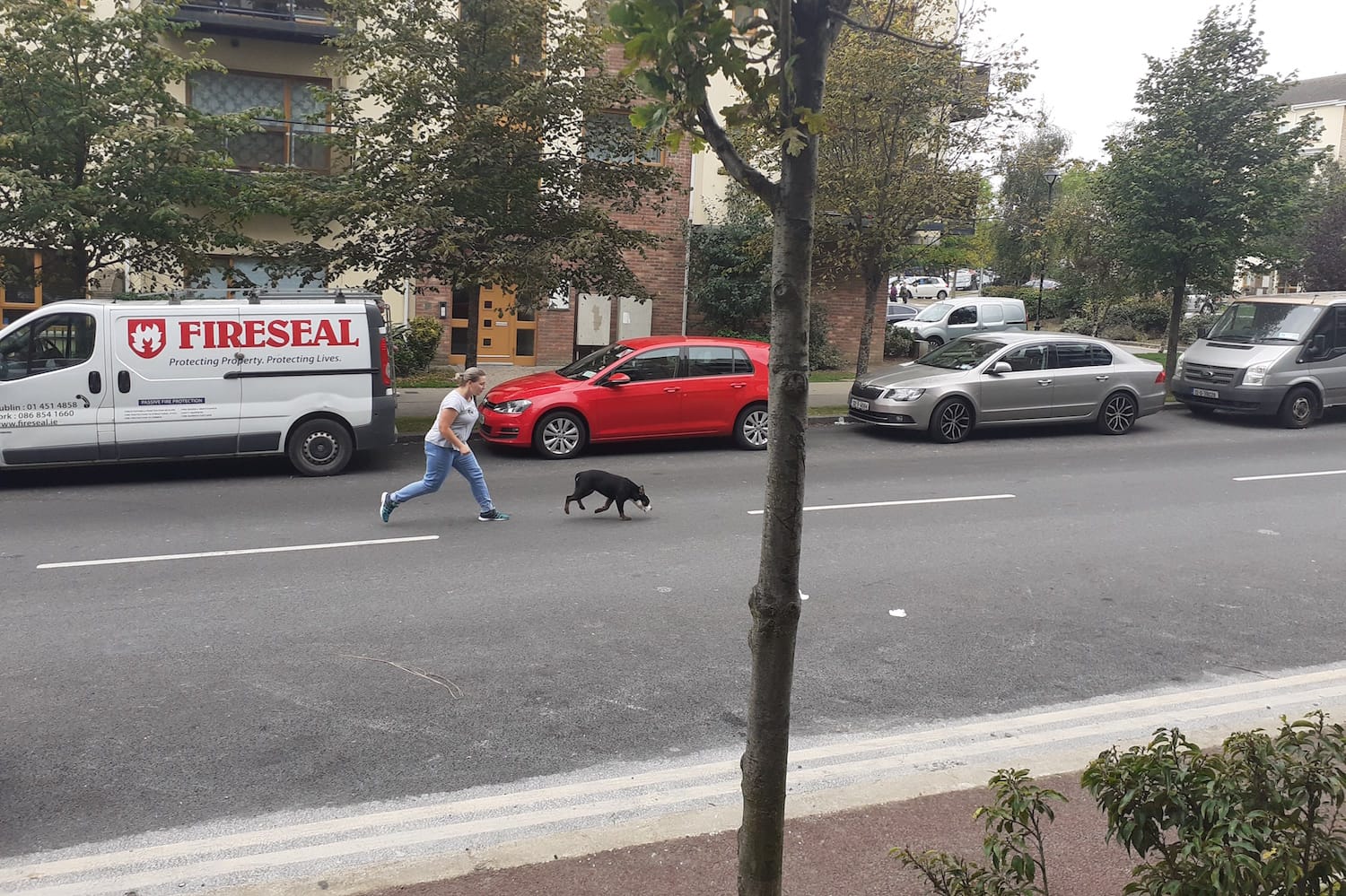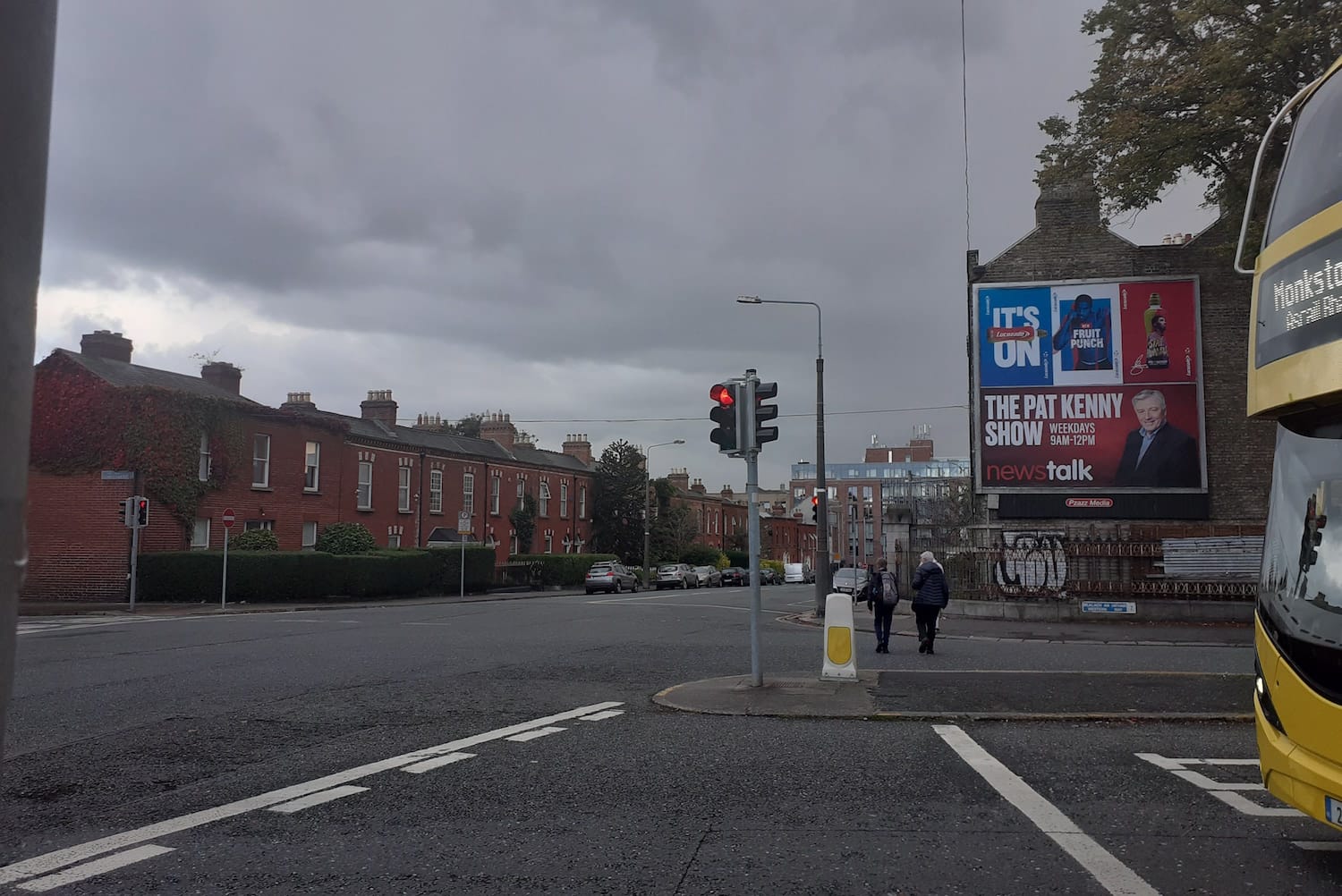What’s the best way to tell area residents about plans for a new asylum shelter nearby?
The government should tell communities directly about plans for new asylum shelters, some activists and politicians say.
Speed surveys earlier this year found that 82% of drivers on Hampton Wood Drive broke the limit, while on Brighton Park none did.

John Hunt has just gotten off the bus, and is waiting to cross Western Way holding the hand of his grandmother, Elisa Forlani.
It’s a busy road, and fast too from the Broadstone end, he says. “But then once you get more here they start getting slow, they start slowing down.”
St Mary’s Chapel of Ease looms above the junction, facing down Western Way, which curves at the end before reaching Broadstone Plaza.
John thinks it’s the straight bit of the road that encourages speed. “It’s almost like a free, kind of just straight, road so they start speeding up.”
Dublin City Council has done a few speed surveys on Western Way, which in recent years has had a limit of 30km/h.
In July 2016, when the road had a limit of 50km/h, roughly 53 percent of drivers broke the speed limit over two days, show the survey results.
In November 2017, by which time the speed limit had dropped to 30km/h, the frequency of speeding had dropped to around 25 percent, a survey suggested.
But about three years later, another speed survey on 22 January 2020 found that 89 percent of drivers broke the speed limit.
Forlani says she and John don’t think anything’s been done to make a difference to the level of speeding.
John crosses here every day to go to primary school nearby, and in the evenings, he thinks people are just tired after work.
“They’d probably be quite hungry so they’d be trying to get back to their families as fast as possible,” he says. “I just think they should go a bit slower.”
It’s not safe for all the kids walking to school, so there should be ramps, and speed cameras, he says.
Dublin City Council didn’t respond to queries on whether they had done or would be doing anything to Western Way as a result of the speed surveys.
In 2021, 24 speed surveys were done by the council, suggest records released under the Freedom of Information Act.
On two roads, Brighton Park and Ringsend Park, the surveys found that no vehicles broke the limit – which in those cases was 50km/h – during the surveyed time.
On 12 roads, fewer than 8 percent of vehicles broke the limit, while on another five roads, between 10 and 20 percent of vehicles did.
Five roads saw more than 20 percent of vehicles break the limit: Henrietta Place (21 percent), Beech Hill Drive (29 percent), Inchicore Terrace South (57 percent), Northbrook Road (68 percent) and Hampton Wood Drive (82 percent).
Out on the street at Hampton Wood Drive in Finglas on Saturday, Gosia Kielbska has her hands full.
She corrals three kids and a dog that she’s minding as she waits for a pickup near her apartment.
It’s the road, she says, that’s causing her the most stress. “They drive like crazy.”
On cue, she interrupts herself. “Get back!” she says, to the kids, who have stepped onto the grass verge before the road as a car zooms by.
She gestures to the car that’s just sped up the avenue. “For example, this one is quite slowly,” she says with a grimace. “For the way that they normally go.”
On 7 April 2021, Dublin City Council put a speed camera up on a lamppost on Hampton Wood Drive, a curved road in North Finglas, which was built as part of a development granted planning in 2007.
Facing onto the road are four-storey apartment blocks, and along the road are parking spaces.
Between 7am and 7pm on 7 April, 1,502 motor vehicles went by, the speed survey results say: 1,085 cars, and the rest either trucks (131), vans (259) or two-wheelers (27).
Nearly all of them, almost 82 percent, were speeding. Twenty percent were going between 41km/h and 45km/h, while more than 14 percent were going over 50km/h.
Dublin City Council has not yet responded to queries on what triggered its speed survey there and what, if anything, it plans to do based on the results.
Kielbska has to cross the road every day, she says, to go to the only shop in the apartment complex, or walk her kids to the distant park. “To cross the road is like a disaster. There’s nothing here, no path, no crossing.”
Roxy the puppy trots towards the road following her nose. Kielbska springs to chase her back, and Roxy playfully hops further into the path of an oncoming car – which, this time, slows.

Briege Mac Oscar, a Fianna Fáil councillor, says Hampton Wood Drive was resurfaced by the council around a year ago.
“You’ll often find speeding increases when a road gets resurfaced,” she said. “Something needs to be done about that, whether it’s ramps or like, say, a narrowing of the road.”
When the council is thinking of doing traffic calming, that’s one time it does speed surveys, she says.
“As far as I know, and I’m not certain, but I think that’s what they’re doing at the moment around Hampton Wood,” she says. “As far as I know they’re looking at safety.”
The council does speed surveys when residents, passersby or councillors, say, complain about speeding, says Carolyn Moore, a Green Party councillor.
“Sometimes people’s perception of speeding is not necessarily somebody speeding,” she says. “The engineers do go and take a look and measure speed, and they may find that actually somebody’s doing 50 in a 50 zone, or whatever the case may be.”
Says Mac Oscar: “They’ll look at the look of things, like are traffic-calming measures on the road, whether a road with straight runs, that’s a trigger for speeding.”

Moore says the council’s most common response at the moment to speed is to paint roundels, or speed-limit signs, onto the road.
“The roundels don’t seem to be a particularly effective way of actually persuading people to slow down,” she says.
“Without the traffic interventions [like speed bumps] to actually force people to slow down, signage and roundels and things like that don’t seem to be particularly effective,” she says.
Then, there’s the question of Garda enforcement. In the first quarter of 2021, Gardaí issued 1,157 fixed-charge notices for speeding in 50 kph, 60km/h and 80km/h zones in the Dublin Metro Region, said a presentation to councillors in May.
But there were no fines listed for breaking limits in 30kph zones, which, council officials had said a year earlier, Gardaí weren’t enforcing.
That prompted debate around whether more Garda enforcement or better road design would be more successful in dealing with speeding in the city.
Janet Horner, a Green Party councillor, says she was told by the council that the 30km/h speed limit doesn’t necessarily mean everyone drives at that speed, but that they do go slower than if it were 50km/h.
“So that’s the kind of thing that makes the speed limits work,” she says.
When Dublin City Council lowered speed limits on 40 streets to 30km/h in December 2016 and March 2017, it did before-and-after surveys of the effects.
It pinpointed the “V85” speed, in other words, the speed at which 85 percent of traffic travels at or below – and so the speed at which 15 percent of traffic violates on average.
Of the 40 spots looked at, 31 saw a fall in these “V85” speeds, while eight saw increases, and one saw no change, says a council evaluation report from November 2020.
Horner throws out an idea. Maybe, instead of speed limits, there should be “speed targets”, she says.
“I don’t know how you would pull it off, but if you could reward drivers who drive closer to the target,” she says.
On Western Way in the north city centre – where, on one day in January 2020, 89 percent of drivers broke the speed limit – passersby say they are still aware of the dangers that the road holds, particularly when it’s time to cross the road.
Turning the corner from Mountjoy Street onto Western Way, Niamh Black says she thinks she’ll wait to cross until she gets to Broadstone Plaza, as she heads west to Smithfield.
“Because you can’t see,” she says, as the bend in the road means drivers could quickly appear, going fast enough that she would be in danger.
A crossing midway down makes sense, she says. Most people wouldn’t walk in the opposite direction around the Mountjoy Street junction, instead of just jaywalking across Western Way. “I know we have, like, this crossing, but for people who need to, like, go down the street.”
John and his grandmother, Forlani, turn towards Mountjoy Street, straining to find a gap in traffic.
“It’s like this every time,” says Forlani. “You have to take a chance sometimes, like now. Should I go?”
John sees a fair amount of dangerous driving, he says. “Not all the time, but quite recently there’s been quite a few crashes here at the intersection.”
“Oh yeah,” says Forlani, her eyes widening.
John thinks there needs to be a pedestrian crossing, he says . “Then I think they should put a speed thing with the cameras.”
Horner, the Green Party councillor, said that with there being no houses or crowds of people walking along the quiet Western Way, there are no typical signals to drivers that they ought to slow down.
The long walls bordering the edges, and the tall trees, don’t give an impression of it being a living street, she says.
“I’m not really surprised that people would be speeding along there, because of potentially the design of it,” she says.
There should be more visual cues that the road is used frequently, she says, as the lack of speed bumps and the wide road sends the opposite message.
“There’s a lot that can be done with the physical infrastructure of the street to send cues to people walking and driving that it’s safe, it’s comfortable,” she says.
Get our latest headlines in one of them, and recommendations for things to do in Dublin in the other.